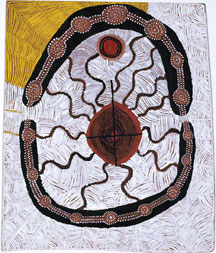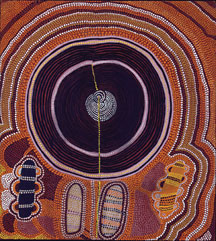Symposium looks at Australia's aboriginal artists
By Daniel Aloi

A Feb. 14 symposium at the Herbert F. Johnson Museum of Art, "Papunya Then and Now," will look at the development and the global reach of an Australian aboriginal painting movement.
It complements the groundbreaking exhibition, "Icons of the Desert: Early Aboriginal Paintings from Papunya," currently at the museum.
The exhibition of 50 works, drawn from the collection of Barbara and John Wilkerson, Ph.D. '70, includes some of the earliest paintings by Papunya movement founders and have never before been shown as a group. The early paintings, made on small boards in the early 1970s, are the first artworks ever to transfer the designs of desert ceremonial imagery to a permanent surface.

The all-day symposium will bring together experts from the United States and Australia to consider the confluence of events that brought about the so-called "dot-painting" movement in the small desert settlement of Papunya, and explain the work's continued relevance in the global art world.
Artists Bobby West Tjupurrula and Joseph Jurra Tjapaltjarri of the Papunya Tula Artists collective will reflect on the work of their elders in the exhibition and will explain the significance of the large "ground work" that they will create with sand and plant fibers in the exhibition gallery in the days leading up to the symposium.
Participants will offer personal reminiscences of individual painters and their place within the movement, address the stylistic development of the paintings and their market, and track the relationship of the works back to ceremonial body painting.
There will also be a discussion of the role of Papunya Tula in the self-governance and welfare of Western Desert Aboriginal communities today.
The symposium is free to advance registrants by e-mailing Elizabeth Saggese at eas8@cornell.edu by Feb. 6; include name, address, daytime phone number and e-mail address in your e-mail. For more information, call 607-254-4642.
Related events at the museum include:
- A lecture, "Aboriginal Art From Papunya Tula: From the Beginning" by guest curator Roger Benjamin of the University of Sydney, Feb. 12 at 5:15 p.m.
- A free reception for all winter exhibitions at the Johnson Museum, Feb. 13 from 5 to 7 p.m.
- "A Day of Australian Art and Culture," March 1 from 1 to 4 p.m., with activities for all ages and a performance of "Yanagai! Yanagai!" by the Australian Aboriginal Theatre Initiative.
- Also, an Australian Film Series, now through Feb. 12 at Cornell Cinema, is featuring "Mick and the Moon" (1978), "Benny and the Dreamers" (1993), "The Tracker" (2002) and "Ten Canoes" (2006). See http://cinema.cornell.edu for screening times and ticket information.
"Icons of the Desert" and the "ground work" installation by Tjupurrula and Tjapaltjarri will be on display at the museum through April 5.
The symposium, exhibition and related programs are supported by the Actus Foundation and the Cornell Council for the Arts.
The exhibition was organized by the Johnson Museum and will travel later this year to the Fowler Museum at the University of California-Los Angeles and the Grey Art Gallery at New York University. For more information, visit http://museum.cornell.edu.
Media Contact
Nicola Pytell
Get Cornell news delivered right to your inbox.
Subscribe